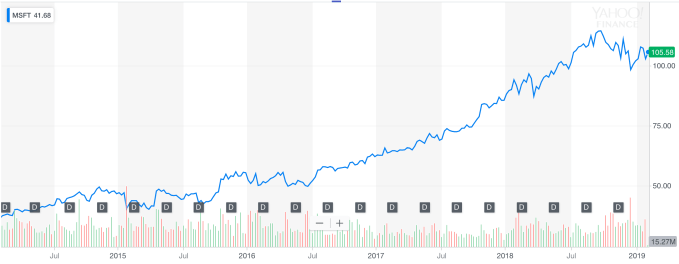03 Feb After 5 years, Microsoft CEO Satya Nadella has transformed more than the stock price
Five years ago today, Satya Nadella took over as CEO at Microsoft, and by most any measure has been wildly successful. It’s common to look at the stock price as the defining metric of Nadella’s tenure, but the stock price triumph has followed something more fundamental and harder to measure: how he changed the culture of the entire organization.
Nadella’s term at Microsoft has paralleled my own here at TechCrunch. I started in April of 2014, and in one of my first posts, I wrote about the difficulty of substantive change inside an organization the size of Microsoft. In those early moments of both our tenures, I recognized a subtle shift was taking place, one toward service, something Microsoft hadn’t been known for under his predecessors Steve Ballmer and Bill Gates.

Microsoft’s five-year stock price journey under Satya Nadella. Stock chart: Yahoo Finance
But Nadella’s inauguration came at a time when technology itself was shifting, moving from a monolithic model — where IT shopped mostly at one vendor, and they were a Microsoft shop or an Oracle shop or an IBM shop, buying a full stack of products — to one where they subscribe to cloud services and choose the best of breed.
This was also happening against the backdrop of the Consumerization of IT, where power was shifting from large administrative departments to users and teams. Nadella seemed to understand all of this.
The shift in strategy, as I wrote, probably began long before Nadella was handed the keys to the CEO office, but perhaps it took a different kind of leader, like Nadella, to turn the battleship that was Microsoft Corporation. Every company has its own politics and biases, and I’m sure Microsoft did as well, but Nadella seemed to manage those, reorganizing the company over time, and shifting priorities. It didn’t come without the pain of layoffs, including one in 2017 when thousands of people were let go. Long-time executives like COO Kevin Turner and head of Windows and devices, Terry Myerson, also left the company.
But Microsoft went from a company trying to compel customers to buy an all-Microsoft, all-the-time kind of approach to one that recognized it was important to work across platforms and to partner widely. To show how serious he was, a year after he started, Nadella set aside his differences with Marc Benioff and Salesforce, and appeared at Dreamforce, Salesforce’s massive customer conference. That was hugely symbolic, given the two companies had engaged in dueling lawsuits over the years, but this was a new day at Microsoft, and Nadella was out to prove it.
In a quote I’ve come back to a number of times over the years, Nadella laid out his new vision of cooperation. While he was going to compete fiercely, of course, he also was going to cooperate where it made sense, because customers demanded it — and under Nadella, it’s all about the customer.
“It is incumbent upon us, especially those of us who are platform vendors to partner broadly to solve real pain points our customers have,” Nadella said at the time. He wasn’t ceding markets, or failing to compete when it mattered, but he also recognized to make customers happy, he had to partner when it made sense.
Back in the days before Satya, partners and developers talked about a much more hostile environment, where it was difficult to get things done, to get the resources they needed, and the attitude was not one of cooperation, but almost hostility. That changed under Nadella, and he should get credit for that.
That all matters, of course, because in the age of the cloud, Nadella’s Dreamforce quote is spot on. Customers expect vendors to cooperate. They expect open APIs. They expect the platform to be friendly to developers — and under Nadella’s leadership, all of this has happened.
The company has also paid closer attention to issues like accessibility, with features such as real-time captions and the new Xbox adaptive controller. Microsoft has instituted programs under Nadella to use AI to improve accessibility, and he has also spoken frequently about responsible AI development.
Nadella has also led an aggressive acquisition strategy using his company’s cash to buy companies big and small. The splashiest acquisitions were LinkedIn for a whopping $26.2 billion in 2016 and GitHub for $7.5 billion last year, but there have been a host of much smaller purchases, most for much less than a billion dollars, that have filled in holes around security, developer productivity, gaming and a wide variety of cloud services.
It is exceedingly difficult to successfully navigate these kinds of broad cultural changes inside a large organization, and while it is probably still a work in progress, Nadella has been mostly effective to this point. The stock price has followed that broader change, but it is not the story here. The story is one of leadership and change management inside a large organization.
Sorry, the comment form is closed at this time.